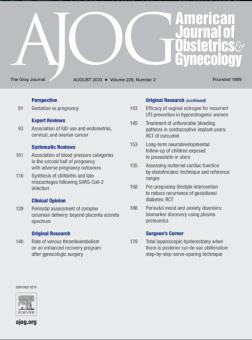
Contact: Christina M. Ackerman-Banks
Email: Christina.m.ackerman@gmail.com
Background
Despite the well-known association between hypertensive disorders of pregnancy and cardiovascular diseases, there are limited data on which specific cardiovascular diagnoses have the greatest risk profiles during the first 24 months after delivery. Most existing data on hypertensive disorders of pregnancy and short-term cardiovascular disease risks are limited to the immediate postpartum period; however, it is crucial to determine cardiovascular disease risk up to 24 months after delivery to inform cardiovascular disease screening protocols during the extended postpartum period.
Objective
This study aimed to delineate the risk of cardiovascular diagnoses in the first 24 months after delivery among patients with hypertensive disorders of pregnancy compared with patients without hypertensive disorders of pregnancy.
Study Design
This longitudinal population-based study included pregnant individuals with deliveries during 2007 to 2019 in the Maine Health Data Organization’s All Payer Claims Data. This study excluded patients with preexisting cardiovascular disease, with multifetal pregnancies, or without continuous insurance during pregnancy. Hypertensive disorders of pregnancy and cardiovascular diseases (categorized by specific conditions: heart failure, ischemic heart disease, arrhythmia or cardiac arrest, cardiomyopathy, cerebrovascular disease or stroke, and new chronic hypertension) were identified using International Classification of Diseases, Ninth Revision, and International Classification of Diseases, Tenth Revision, diagnosis codes. Cox proportional hazards models were used to estimate hazard ratios, adjusting for potential confounding factors.
Results
Of the 119,422 pregnancies examined, the cumulative risk of cardiovascular disease within 24 months after delivery for those with hypertensive disorders of pregnancy vs those without hypertensive disorders of pregnancy was 0.6% vs 0.2% for heart failure, 0.3% vs 0.1% for ischemic heart disease, 0.2% vs 0.2% for arrhythmia or cardiac arrest, 0.6% vs 0.2% for cardiomyopathy, 0.8% vs 0.4% for cerebrovascular disease or stroke, 1.6% vs 0.7% for severe cardiac disease (composite outcome of heart failure, cerebrovascular disease or stroke, or cardiomyopathy), and 9.7% vs 1.5% for new chronic hypertension. After adjustment for potential confounders, those with hypertensive disorders of pregnancy had an increased risk of heart failure, cerebrovascular disease, cardiomyopathy, and severe cardiac disease within the first 24 months after delivery (adjusted hazard ratio, 2.81 [95% confidence interval, 1.90–4.15], 1.43 [95% confidence interval, 1.07–1.91], 2.90 [95% confidence interval, 1.96–4.27], and 1.90 [95% confidence interval, 1.54–2.30], respectively) compared with those without hypertensive disorders of pregnancy. In addition, those with hypertensive disorders of pregnancy had an increased risk for new chronic hypertension diagnosed after 42 days after delivery (adjusted hazard ratio, 7.29; 95% confidence interval, 6.57–8.09). There was no association between hypertensive disorders of pregnancy and ischemic heart disease (adjusted hazard ratio, 0.92; 95% confidence interval, 0.55–1.54) or cardiac arrest or arrhythmia (adjusted hazard ratio, 0.90; 95% confidence interval, 0.52–1.57). In addition, among women with hypertensive disorders of pregnancy, the highest proportion of first cardiovascular disease diagnoses occurred during the first month after delivery for cardiomyopathy (44%), heart failure (39%), cerebrovascular disease or stroke (39%), and severe cardiac disease (41%).
Conclusion
Patients with hypertensive disorders of pregnancy had an increased risk of developing new chronic hypertension, heart failure, cerebrovascular disease, and cardiomyopathy within 24 months after delivery. There was no association between hypertensive disorders of pregnancy and ischemic heart disease or cardiac arrest or arrhythmia. Patients with hypertensive disorders of pregnancy need targeted early postpartum interventions and increased monitoring in the first 24 months after delivery. This may preserve long-term health and improve maternal and neonatal outcomes in a subsequent pregnancy.
